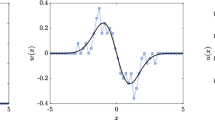Abstract
We introduce a new advection scheme for fluid animation. Our main contribution is the use of long-term temporal changes in pressure to extend the commonly used semi-Lagrangian scheme further back along the time axis. Our algorithm starts by tracing sample points along a trajectory following the velocity field backwards in time for many steps. During this backtracing process, the pressure gradient along the path is integrated to correct the velocity of the current time step. We show that our method effectively suppresses numerical diffusion, retains small-scale vorticity, and provides better long-term kinetic energy preservation.
Article PDF
Similar content being viewed by others
Explore related subjects
Discover the latest articles, news and stories from top researchers in related subjects.Avoid common mistakes on your manuscript.
References
Selle, A.; Fedkiw, R.; Kim, B.; Liu, Y.; Rossignac, J. An unconditionally stable MacCormack method. Journal of Scientific Computing Vol. 35, Nos. 2–3, 350–371, 2008.
Stam, J. Stable fluids. In: Proceedings of the 26th Annual Conference on Computer Graphics and Interactive Techniques, 121–128, 1999.
Xiu, D.; Karniadakis, G. E. A semi-Lagrangian highorder method for Navier–Stokes equations. Journal of Computational Physics Vol. 172, No. 2, 658–684, 2001.
Tessendorf, J.; Pelfrey, B. The characteristic map for fast and efficient VFX fluid simulations. In: Proceedings of the Computer Graphics International Workshop on VFX, Computer Animation, and Stereo Movies, 2011.
Bridson, R. Fluid Simulation for Computer Graphics, 2nd edn. Taylor & Francis, 2015.
Shu, C. W. Essentially non-oscillatory and weighted essentially non-oscillatory schemes for hyperbolic conservation laws. In: Advanced Numerical Approximation of Nonlinear Hyperbolic Equations. Lecture Notes in Mathematics, Vol. 1697. Quarteroni, A. Ed. Springer Berlin Heidelberg, 325–432, 1998.
Takewaki, H.; Yabe, T. The cubic-interpolated pseudo particle (CIP) method: Application to nonlinear and multi-dimensional hyperbolic equations. Journal of Computational Physics Vol. 70, No. 2, 355–372, 1987.
Foster, N.; Fedkiw, R. Practical animation of liquids. In: Proceedings of the 28th Annual Conference on Computer Graphics and Interactive Techniques, 23–30, 2001.
Heo, N.; Ko, H.-S. Detail-preserving fully-Eulerian interface tracking framework. In: Proceedings of the ACM SIGGRAPH Asia 2010 Papers, Article No. 176, 2010.
Hachisuka, T. Combined Lagrangian–Eulerian approach for accurate advection. In: Proceedings of the ACM SIGGRAPH 2005 Posters, Article No. 114, 2005.
Hachisuka, T. Advection equation solver using mapping functions. Thesis for Bachelor of Engineering. 2006. Available at https://doi.org/www.ci.i.u-tokyo.ac.jp/hachisuka/bt.pdf.
Zhu, Y.; Bridson, R. Animating sand as a fluid. In: Proceedings of the ACM SIGGRAPH 2005 Papers, 965–972, 2005.
Mullen, P.; Crane, K.; Pavlov, D.; Tong, Y.; Desbrun, M. Energy-preserving integrators for fluid animation. In: Proceedings of the ACM SIGGRAPH 2009 Papers, Article No. 38, 2009.
Zhang, X.; Bridson, R.; Greif, C. Restoring the missing vorticity in advection-projection fluid solvers. ACM Transactions on Graphics Vol. 34, No. 4, Article No. 52, 2015.
Lentine, M.; Zheng, W.; Fedkiw, R. A novel algorithm for incompressible flow using only a coarse grid projection. In: Proceedings of the ACM SIGGRAPH 2010 Papers, Article No. 114, 2010.
Acknowledgements
This work was supported by NSERC (Grant RGPIN-04360-2014) and JSPS KAKENHI (Grant 17H00752). The authors thank Toshiya Hachisuka for insightful discussions.
Author information
Authors and Affiliations
Corresponding author
Additional information
Takahiro Sato is an M.S. student at Computer Science Department, the University of Tokyo. His research interest is focused on physics simulation for applications in computer graphics.
Christopher Batty is an assistant professor of computer science at the University of Waterloo. His research is focused on the development of novel physical simulation techniques for applications in computer graphics and computational physics, with an emphasis on the diverse behaviors of fluids.
Takeo Igarashi is a professor at Computer Science Department, the University of Tokyo. He received his Ph.D. degree from Information Engineering Department, the University of Tokyo, in 2000. His research interest is in user interface in general and current focus is on interaction techniques for 3D graphics.
Ryoichi Ando is an assistant professor at National Institute of Informatics. His research interest is focused on physics simulation for computer graphics, with a strong emphasis on fluid animation.
Electronic supplementary material
Rights and permissions
Open Access This article is licensed under a Creative Commons Attribution 4.0 International License, which permits use, sharing, adaptation, distribution and reproduction in any medium or format, as long as you give appropriate credit to the original author(s) and the source, provide a link to the Creative Commons licence, and indicate if changes were made.
The images or other third party material in this article are included in the article’s Creative Commons licence, unless indicated otherwise in a credit line to the material. If material is not included in the article’s Creative Commons licence and your intended use is not permitted by statutory regulation or exceeds the permitted use, you will need to obtain permission directly from the copyright holder.
To view a copy of this licence, visit https://creativecommons.org/licenses/by/4.0/.
About this article
Cite this article
Sato, T., Batty, C., Igarashi, T. et al. Spatially adaptive long-term semi-Lagrangian method for accurate velocity advection. Comp. Visual Media 4, 223–230 (2018). https://doi.org/10.1007/s41095-018-0117-9
Received:
Accepted:
Published:
Issue Date:
DOI: https://doi.org/10.1007/s41095-018-0117-9




